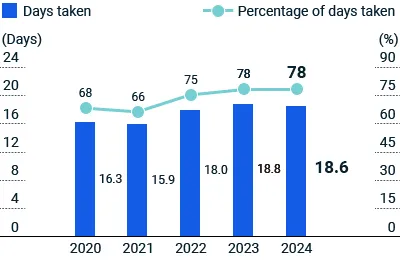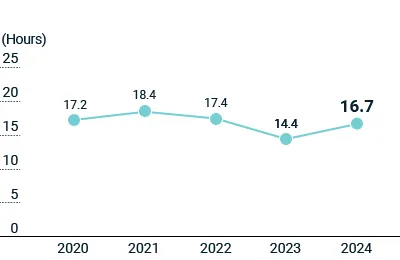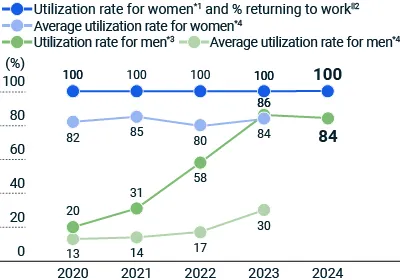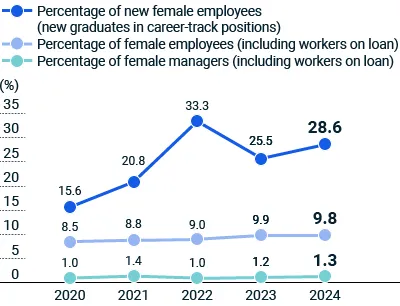Better Workplace Environment
Efforts to Retain and Empower Employees
Progress in Diverse Work Styles and Work Efficiency
We carry out a wide range of initiatives, including expanding work-style diversity to encompass telecommuting, flextime, and the like, implementing five-day holidays and no-overtime days, supporting employees in balancing work with childcare and nursing care, and hosting work-style reform seminars. These efforts have enabled us to reduce overtime work and increase the taking of paid leave. Employees reap the rewards of these efforts in the form of human resource investments such as expanded job benefits and IT funding. We will continue to pursue improvements as we review and revise our efforts.
Main Initiatives
-
Inventory business tasks
-
Reform meeting processes (shorten, etc.)
-
Actively use IT
-
Encourage employees to take five consecutive days of leave taken twice a year
-
Implement no-overtime days
-
Conduct work-style reform seminars
-
Create a new return-to-work system
-
Expand the work-from-home system
-
Increase worksites eligible for flextime and shorter core working hours
-
Revise system to comply with the amended Child Care and Family Care Leave Act
-
Provide child- and nursing care information
-
Conduct employee awareness surveys


Support for Raising the Next Generation and Women’s Empowerment
In February 2019, we received Platinum Kurumin accreditation under the Act on Advancement of Measures to Support Raising Next-Generation Children in Japan and have continued providing such support in order to expand our employees’ options for work styles conducive to childcare and nursing care. These efforts have helped achieve successes such as realizing an 86% rate (fiscal 2023) of male employees taking their childcare leave.
We have created and will introduce a new voluntary action plan to support employees with children.
We are also taking steps to increase the percentage of female employees. We are taking special steps to cultivate female leaders by strengthening the recruitment of female career-track employees and holding in-house seminars on women’s health issues. Our efforts to reach our consolidated-basis target of 10% female managers by fiscal 2028 raised the percentage to 11.7% in fiscal 2024.
Performance indicators for employees with children
Period: January 1, 2025 to December 31, 2028
-
Maintain at least 80% eligible male employees taking childcare leave and aim for 100%
-
Create a flexible family support structure for employees balancing childcare and work based on individual family situations
-
Maintain a minimum average of 17 days of paid leave being used
We will continue to implement measures to realize diverse work styles according to employees’ needs by, for example, increasing the childcare leave utilization rate among men, reducing overtime work, increasing paid leave taken, and encouraging the use of other various programs.
Childcare leave utilization rate
Since fiscal 2015, both men and women at NEG have taken childcare leave at a rate higher than the national average. With revisions to Japan’s Child Care and Family Care Leave Act in fiscal 2022, we held explanatory meetings for the various employee groups eligible for leave. We have seen a particularly large rise in the childcare leave utilization rate for men, which has remained above 80% for two straight years.
Women Returning to Work (%, NEG)

-
Utilization rate for women: Number of people taking childcare leave ÷ Number of employees giving birth × 100
-
Percentage returning to work: After giving birth, percentage of people working continuously when child has turned 1 year old
-
Utilization rate for men: Number of men taking childcare leave ÷ Number whose spouses gave birth × 100
-
Source: Statistics on national average childcare leave utilization rate for men and women, taken from Basic Survey of Gender Equality in Employment Management; Ministry of Health, Labour and Welfare
Women’s empowerment
We are stepping up recruitment of female career-track employees, increasing the ratio of female employees, and developing female leaders. We are also creating supportive working environments and workplaces for women by holding in-house seminars on women’s health issues and fostering a corporate culture and workplace environment that accommodates diverse opinions and ideas.

In fiscal 2023, although the percentage of new female employees dropped from the previous fiscal year, the number of new female employees rose by 60%.
Indicators and Targets for Progress in Women’s Empowerment
Period: January 1, 2025 to December 31, 2028
-
Make 25% or higher*1 the indicator for percentage of new female employees (new graduates in career-track positions) at NEG.
-
Target the percentage of female managers by fiscal 2028 to be at least double (2.0% or more) that of fiscal 2022 at NEG.
-
Target the percentage of female managers at NEG and at consolidated subsidiaries in Japan and overseas to be at least 10%*2 by fiscal 2028.
Notes:
*1 Above 25% since fiscal 2022
*2 Target achieved with 11.7% in fiscal 2024
| Indicators | Gender | FY2020 | FY2021 | FY2022 | FY2023 | FY2024 |
|---|---|---|---|---|---|---|
| Number of employees | Men | 1,524 | 1,530 | 1,530 | 1,541 | 1,569 |
| Women | 149 | 152 | 157 | 172 | 177 | |
| Total | 1,673 | 1,682 | 1,687 | 1,713 | 1,746 | |
| Average years of service | Men | 24.1 | 24.3 | 23.8 | 22.9 | 21.9 |
| Women | 19.7 | 18.8 | 17.8 | 16.2 | 14.6 | |
| Total | 23.7 | 23.8 | 23.2 | 22.2 | 21.2 | |
| Turnover rate (%) | - | 1.6 | 1.2 | 1.3 | 1.9 | 2.0 |
-
Number of employees and average years of service do not include employees on loan.
-
Years of service is on a downward trend because of the increase in male and female new hires.
-
We strive for an environment conducive to a comfortable long-term workplace, and the result has been a low employee turnover rate.

Period: Fiscal 2024 (January 1 to December 31, 2024)
Wages: Includes compensation for overtime and bonuses, but excludes commuting allowance, etc.
Regular employees: Excludes employees on loan from NEG to other companies, or from other companies to NEG
Part-time and fixed-term employees: Employees who have an employment contract for a fixed period
-
Notes:
-
Although we calculate wages for men and women based on the same standard, male-female wage gaps occur due to differences in things such as number of employees, employment categories, and years of continuous service. Other factors contributing to wage gaps include various allowances for shift work employees (of whom 98% are men) and the fact that there are relatively fewer women in senior management positions.
-
In the employee category of part-time and fixed-term employees, the difference in employment categories is a major reason for wage gaps.
Employee Awareness Surveys
As in fiscal 2023, this past year we conducted employee awareness surveys with the aim of creating a workplace where employees can succeed while enjoying rewarding work. The results were reported to the Management Committee and department heads, with feedback then given to all employees. Results of the surveys are used to analyze the strengths and weaknesses of the company as a whole and its individual workplace organizations, which is followed by improvement activities where necessary.
Cycle for strengthening engagement
-
Conduct main surveys
Results analysis; feedback to management, department heads, and employees
-
Plan and implement measures company-wide and in each workplace based on survey results
Activities implementation
-
Conduct focused surveys
Use specific-issue-focused surveys to monitor whether measures are working effectively and, if not, revise those measures
-
Conduct main surveys
Do main surveys the following year and confirm yearly changes
| Aim | Visualize state of organization, and improve it at the company-wide and workplace levels |
|---|---|
| Total number of respondents | 1,938 (1,955 for FY2023) |
| Response rate | 99.6% (99.7% for FY2023) |
| Results summary | • Expectations and satisfaction scores increased from the previous fiscal year for each category of engagement • Continuing from last fiscal year, there was a high level of satisfaction with cooperation in the workplace and supportive actions of superiors, fostering a sense of unity in the workplace |
Setting the fiscal 2023 score as 100, the fiscal 2024 score increased slightly to 102, but the scores for expectations and satisfaction were the same or higher in all 16 engagement categories (with 64 individual sections). We view increase in expectations and the high response to the survey as indicating that employees support the organizational changes and consider them to be positive improvements.
We will continue to conduct surveys and use the results to guide improvements as part of our efforts to build vibrant workplaces.
Freedom of Association and Labor-Management Relations
The NEG Group respects rights afforded to workers by the laws of the countries it operates in, including freedom of association and collective bargaining. Our employees are in the NEG labor union, which is a member of the Japanese Electrical Electronic & Information Union (JEIU). Based on the union shop agreement, membership in the labor union is open to all regular employees except those in management positions. As of December 2024, 78.3% of all NEG employees were in the union.
NEG confirms working conditions by signing agreements with its labor union. Besides monthly meetings at NEG sites between the NEG labor union and the company, the union’s executive committee and company senior management meet to exchange opinions at least twice a year. We also strive to maintain amicable labor-management relations through a wide range of other cooperation in areas such as occupational safety and health, health and productivity management, and support for raising the next generation.